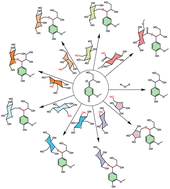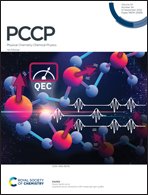Origins of covalent linkages within the lignin–carbohydrate network of biomass†
Abstract
Covalent linkages between lignin and the surrounding carbohydrate network, often referred to as lignin–carbohydrate complexes (LCCs), have been proposed to affect the organization of the biomass microstructure and directly correlate with the recalcitrant nature of biomass. However, the existence and frequency of these LCC linkages remain controversial and largely unknown, primarily due to the harsh experimental techniques available to characterize them. During the predominant lignin polymerization pathway a reactive intermediate is formed. Though this intermediate can covalently bind to the surrounding cellulose/hemicellulose matrix, it has been traditionally assumed to react exclusively with water, leading to purely physical interactions between lignin and cellulose/hemicellulose in the cell wall. This work, for the first time, provides direct evidence of the molecular mechanism of the formation of benzyl ether and benzyl ester LCC linkages via the speculated lignin polymerization pathway. The formation of these LCC linkages showed thermodynamic favorability, while remaining kinetically facile, compared to the previously assumed mechanism of the lignin intermediate reacting with water. The present work suggests that the surrounding carbohydrate matrix could play a role in the organization of lignin deposition and these covalent linkages could be a key factor in biomass recalcitrance.



 Please wait while we load your content...
Please wait while we load your content...